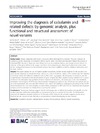Identificador persistente para citar o vincular este elemento:
https://accedacris.ulpgc.es/handle/10553/49344
| Título: | Improving the diagnosis of cobalamin and related defects by genomic analysis, plus functional and structural assessment of novel variants | Autores/as: | Brasil, Sandra Leal, Fátima Vega, Ana Navarrete, Rosa Ecay, María Jesús Desviat, Lourdes R. Riera, Casandra Padilla, Natàlia De La Cruz, Xavier Couce, Mari Luz Martin-Hernández, Elena Morais, Ana Pedrón, Consuelo Peña-Quintana, Luis Rigoldi, Miriam Specola, Norma De Almeida, Isabel Tavares Vives, Inmaculada Yahyaoui, Raquel Rodríguez-Pombo, Pilar Ugarte, Magdalena Pérez-Cerda, Celia Merinero, Begoña Pérez, Belén |
Clasificación UNESCO: | 320102 Genética clínica | Palabras clave: | Methylmalonic Aciduria Inborn Error Vitamin-B-12 Metabolism Sequence Variants B-12 Trafficking, et al. |
Fecha de publicación: | 2018 | Publicación seriada: | Orphanet Journal of Rare Diseases | Resumen: | Background: Cellular cobalamin defects are a locus and allelic heterogeneous disorder. The gold standard for coming to genetic diagnoses of cobalamin defects has for some time been gene-by-gene Sanger sequencing of individual DNA fragments. Enzymatic and cellular methods are employed before such sequencing to help in the selection of the gene defects to be sought, but this is time-consuming and laborious. Furthermore some cases remain undiagnosed because no biochemical methods have been available to test for cobalamin absorption and transport defects.Results: This paper reports the use of massive parallel sequencing of DNA (exome analysis) for the accurate and rapid genetic diagnosis of cobalamin-related defects in a cohort of affected patients. The method was first validated in an initial cohort with different cobalamin defects. Mendelian segregation, the frequency of mutations, and the comprehensive structural and functional analysis of gene variants, identified disease-causing mutations in 12 genes involved in the absorption and synthesis of active cofactors of vitamin B12 (22 cases), and in the non-cobalamin metabolism-related genes ACSF3 (in four biochemically misdiagnosed patients) and SUCLA2 (in one patient with an unusual presentation). We have identified thirteen new variants all classified as pathogenic according to the ACGM recommendation but four were classified as variant likely pathogenic in MUT and SUCLA2. Functional and structural analysis provided evidences to classify them as pathogenic variants.Conclusions: The present findings suggest that the technology used is sufficiently sensitive and specific, and the results it provides sufficiently reproducible, to recommend its use as a second-tier test after the biochemical detection of cobalamin disorder markers in the first days of life. However, for accurate diagnoses to be made, biochemical and functional tests that allow comprehensive clinical phenotyping are also needed. | URI: | https://accedacris.ulpgc.es/handle/10553/49344 | ISSN: | 1750-1172 | DOI: | 10.1186/s13023-018-0862-y | Fuente: | Orphanet Journal of Rare Diseases [ISSN 1750-1172], v. 13: 125 (Julio 2018) |
| Colección: | Artículos |
Citas SCOPUSTM
3
actualizado el 08-jun-2025
Citas de WEB OF SCIENCETM
Citations
2
actualizado el 08-jun-2025
Visitas
95
actualizado el 22-jun-2024
Descargas
89
actualizado el 22-jun-2024
Google ScholarTM
Verifica
Altmetric
Comparte
Exporta metadatos
Los elementos en ULPGC accedaCRIS están protegidos por derechos de autor con todos los derechos reservados, a menos que se indique lo contrario.
